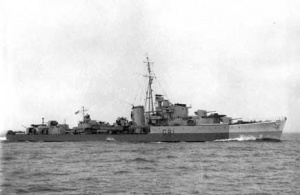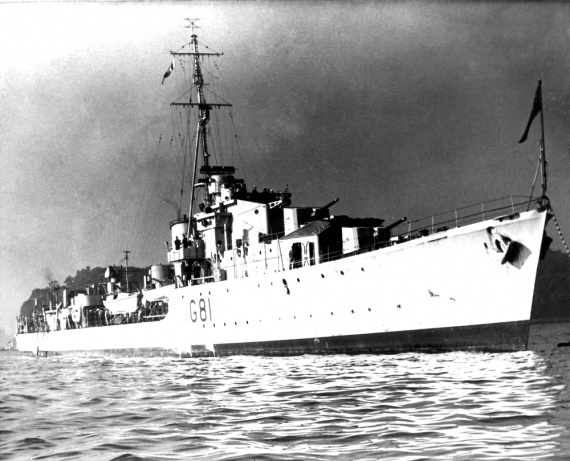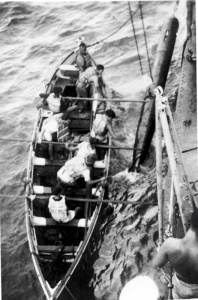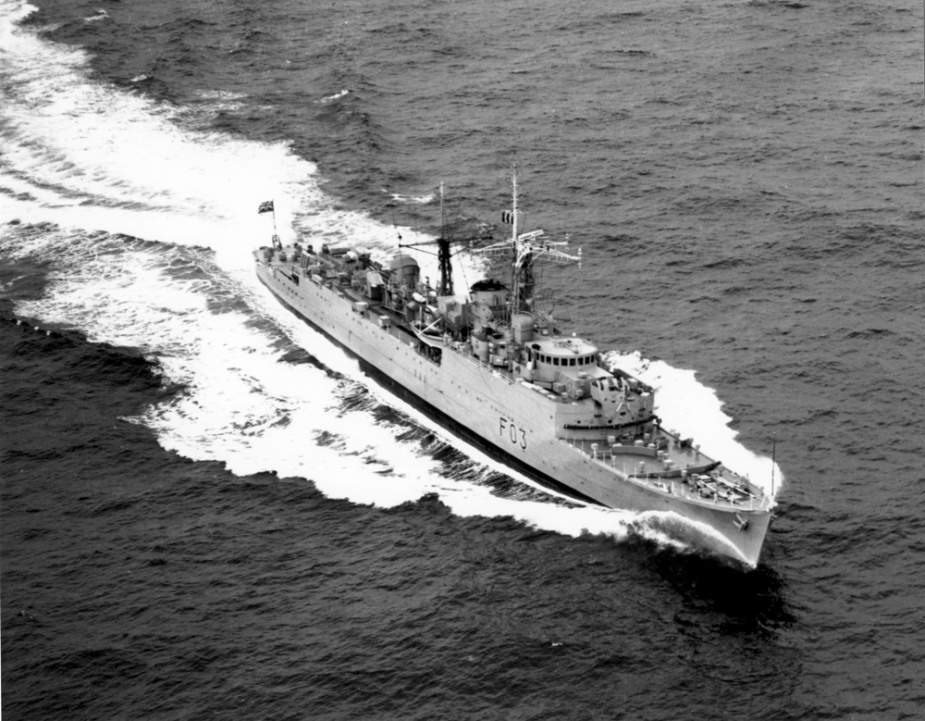HMAS Quiberon
| Class |
Q Class |
|---|---|
| Type |
Destroyer/Anti-submarine Frigate |
| Pennant |
G81/F03 |
| Builder |
J Samuel White & Co Ltd, Cowes, Isle of Wright, England |
| Laid Down |
14 October 1940 |
| Launched |
31 January 1942 |
| Launched by |
Mrs Tillard, wife of Rear Admiral SD Tillard RN, Flag Officer in Charge, Southampton |
| Commissioned |
6 July 1942 |
| Decommissioned |
26 June 1964 |
| Dimensions & Displacement | |
| Displacement |
|
| Length | 358 feet 9 inches |
| Beam | 35 feet 9 inches |
| Draught | 9 feet 6 inches |
| Performance | |
| Speed | 31 knots |
| Complement | |
| Crew | 220 |
| Propulsion | |
| Machinery | Parsons geared turbines, 2 shafts |
| Horsepower | 40,000 |
| Armament | |
| Guns |
|
| Torpedoes | 8 x 21 inch torpedo tubes (as destroyer) |
| Other Armament | 2 triple barrel depth charge mortars |
| Awards | |
| Battle Honours | |
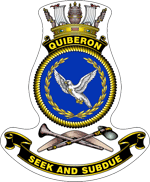
HMAS Quiberon was one of eight Q Class destroyers built for the Royal Navy, although Quiberon was commissioned in the Royal Australian Navy at Cowes, Isle of Wight, on 6 July 1942.
Following commissioning and manned by an Australian crew, Quiberon proceeded to Scapa Flow. Until late August 1942 she was engaged in working up exercises in northern Scottish waters and was then detailed to North Atlantic convoy escort duty. One of her first tasks was to form part of the escort of a twenty-one ship troop convoy bound for Capetown but was detached from this duty to search for a suspected U-Boat supply ship in the Atlantic. After a fruitless search over a wide area Quiberon reached Freetown on 27 September. She then proceeded to Gibraltar and back to British home waters, having steamed 12,000 miles and spent only three out of forty-two days in harbour.
In October 1942 she formed a unit of the large British naval forces assigned to support the Allied landings in North Africa (Operation TORCH). During this period of her service, which took her into the Mediterranean for the first time, Quiberon experienced her first contact with the enemy when she became the frequent target of aircraft. On 28 November 1942, while operating off the Tunisian coast north west of Bone in company of her sister ship HMS Quentin, she attacked and destroyed the Italian submarine Dessie.
On 1 December 1942 Quiberon formed a unit of a force of three cruisers and three destroyers despatched from Bone, Tunisia, to intercept an enemy convoy reported bound from Sicily to Tunis. Contact was made in the early hours of 2 December and all four ships of the convoy and the escorting Italian destroyer Lupo were sunk, but Quentin was sunk by an aircraft torpedo on the way back to Bone and at dawn Quiberon, while under heavy air attack, was called upon to rescue her complement.
Quiberon operated in North African waters on convoy and fleet escort duties for the remainder of December 1942 and throughout January 1943. On 21 December she assisted in rescuing survivors from the liner Strathallan, torpedoed off the Algerian coast by U-562, later landing them at Algiers.
At the end of January 1943 Quiberon left the Mediterranean as a unit of the escort of a convoy bound from England to Capetown. She arrived at Durban on 27 February and from there proceeded to Australia, arriving at Fremantle on 29 March, having steamed 51,000 miles on war service.
After refitting at Melbourne, she returned to the Indian Ocean and at Kilindini, Kenya, in June 1943 joined the British Eastern Fleet. She spent the remainder of 1943 almost constantly at sea escorting Indian Ocean convoys.
In 1944 Quiberon continued serving as an escort destroyer of the Eastern Fleet protecting convoys proceeding mainly between India and Aden. In March 1944, British Indian Ocean naval forces were reinforced, and were able to take the offensive against Japanese held territory. Quiberon took part in the carrier air strikes against Sabang in April 1944 and Sourabaya in May 1944, before returning to Australia for another refit at Melbourne.
Quiberon rejoined the Eastern Fleet at Trincomalee, Ceylon, on 1 August 1944 and resumed escort duty in the Indian Ocean. In October 1944 she took part in a series of fleet bombardments of the Japanese held Nicobar Islands. In mid-December she detached from the Eastern Fleet and returned to Australia, where for the next few weeks she operated as an escort and anti-submarine vessel on the Australia Station.
In March 1945 Quiberon proceeded to Manus, the United States base in the Admiralty Islands, as a unit of the British Pacific Fleet. From Manus she proceeded north to the operational area and was thereafter until the end of hostilities actively engaged in the closing phases of the war at sea against Japan. She took part in operations in support of the American seizure of Okinawa and subsequent attacks on the Japanese homeland. When the war ended in August, she had steamed 236,000 miles on war service.
Peace did not bring immediate respite for Quiberon. She was present at the re-occupation of Shanghai, and then served in the East Indies until February 1946, troop carrying, retrieving prisoners of war and assisting in the re-establishment of Dutch control in the area.
In March 1946, following a short refit at Sydney, she sailed for Japan to begin the first of three periods of occupation duty. She reached Sydney at the end of her third period of Southeast Asia service on 22 July 1948 and was there immobilised, having steamed 80,000 miles in the post war years and a total of 316,772 miles since commissioning. In six years of seagoing service Quiberon had been under way for 20,452 hours, or almost two and a half years. She paid off on 15 May 1950.
In November 1950 the task of converting Quiberon to a modern fast anti-submarine frigate was commenced at Cockatoo Island Dockyard in Sydney. Later the ship was transferred to the Naval Dockyard at Garden Island, Sydney, where the conversion was completed in December 1957.
Quiberon recommissioned on 18 December 1957 as a unit of the 1st Frigate Squadron. When completed by the conversion of three sister ships from destroyers to frigates, the Squadron comprised HMA Ships Quadrant, Queenborough, Quiberon and Quickmatch.
During the following six and a half years, Quiberon spent several periods of duty on Southeast Asia service as a unit of the Commonwealth Strategic Reserve and from time to time operated as a unit of the South East Asia Treaty Organisation forces on periodical exercises in Southeast Asian waters. Otherwise she operated as a unit of the Australian Fleet on the Australia Station. Her service career ended when she paid off to Reserve on 26 June 1964.
Quiberon was sold on 15 February 1972 for breaking up to Fujita Salvage Company Limited of Osaka, Japan, for $68,260. On 10 April 1972 the Japanese tug Sumi Maru No 38 left Sydney for Japan with Quiberon and another former RAN vessel, Tobruk (I), in tow.
Further reading
'Q Class Destroyers and Frigates of the Royal Australian Navy: Destroyers 1942-1956, Frigates 1953-1972' by Trevor Weaver - published by the Naval Historical Society of Australia, Garden Island, 1994.

